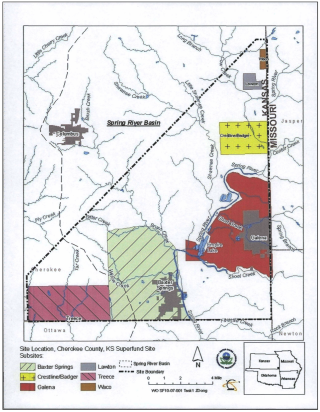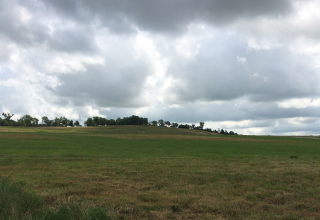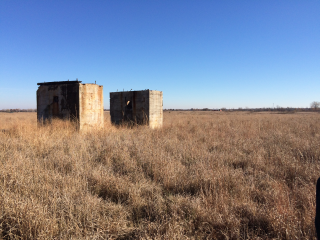Cherokee County National Priorities List (NPL) Superfund Site, Cherokee County, Kansas - Fact Sheet, January 2023
Community Update - Sixth Five-Year Review Summary
In this Community Update:
- Site Overview and Selected Remedies
- Five-Year Review Process
- Five-Year Review Findings
- Five-Year Review Protectiveness Determinations
- Current Status and Next Steps
Introduction

Five-Year Reviews (FYRs) provide an opportunity to evaluate the implementation and performance of a remedy and to determine whether a remedy is protective of human health and the environment. Every five years, EPA issues FYR reports that identify issues and make recommendations to improve the site’s cleanup. This Community Update provides an overview of EPA’s Sixth FYR for the Cherokee County National Priorities List (NPL) Superfund Site (site), completed in September 2020.
Site Overview
The site is a former mining area in southeast Kansas, which is part of a larger mining area known as the Tri-State Mining District. Lead and zinc mining occurred on-site from the mid-1800s to 1970. When mining ended, tailings piles (known locally as chat), tailings impoundments and ponds, open and collapsed mine shafts, and other mining features were left on-site.
Mining and related activities resulted in local areas of contaminated soil, sediments, surface water, and groundwater throughout the 115-square-mile site, depicted in Figure 1 (at right). These areas are contaminated primarily with cadmium, lead and zinc. For more information about lead hazards and how to protect your family, see Additional Information links at the bottom of this page.
EPA divided the site into nine focus/project areas, or Operable Units (OUs). Table 1 summarizes the OUs and their status in the Superfund cleanup process. The 2020 FYR discusses six of the nine OUs. The FYR evaluates only those OUs that have a selected remedy and where at least part of the remedy construction has started. The FYR does not evaluate remedy protectiveness for OU1, because the state of Kansas oversees the public water supply systems in Cherokee County, Kansas.
Table 1: CURRENT STATUS OF ALL OPERABLE UNITS |
||
OU |
Status |
Included in FYR |
|
OU1 – Galena Alternate Water Supply |
Complete; Water utility leads OU1 |
Yes, but remedy not evaluated. |
|
OU2 – Spring River Basin |
Remedial Investigation |
No |
|
OU3 – Baxter Springs |
Under Construction |
Yes |
|
OU4 – Treece |
Under Construction |
Yes |
|
OU5 – Galena Groundwater/Surface Water |
Operation and Maintenance |
Yes |
|
OU6 – Badger, Lawton, Waco, Crestline |
Under Construction |
Yes |
|
OU7 – Galena Residential Soils |
Operation and Maintenance |
Yes |
|
OU8 – Railroads |
Remedial Action |
No, as construction had yet to begin in 2020. EPA expects to begin construction in spring 2023. |
|
OU9 – Tar Creek Watershed |
Remedial Investigation |
No |
|
Note: EPA has not yet selected remedies for OU2 and OU9 as investigations are ongoing. |
||
Selected Remedies
EPA selected remedies for OU1, OU3, OU4, OU5, OU6, OU7, and OU8 in Records of Decision (RODs). EPA has modified some of the original remedies with other decision documents called Explanations of Significant Differences or ROD Amendments. The next paragraphs summarize the major parts of the remedies for these OUs. EPA has conducted some of the cleanup work, while responsible parties have conducted the remainder of the work. Cleanup work has started but is not yet finished at some of the OUs.
For a glossary of Superfund Terms, visit EPA's website.
OU1 (Galena Alternate Water Supply):
The selected remedy included establishing a rural water district, installing new public water supply wells, and connecting residences to the public water supply.
OU3 (Baxter Springs) and OU4 (Treece):
The selected remedies for OU3 and OU4 were similar. They included excavating and capping mine waste areas; removing contaminated stream sediments; stream improvements; closing deep wells; institutional controls; and operation and maintenance activities. The remedies also included soil cleanup of residential yards with lead levels above 800 parts per million (ppm) or cadmium above 75 ppm. The OU4 remedy also included the buyout and remediation of the community of Treece, Kansas.
OU5 (Galena Groundwater/Surface Water):
The remedy for OU5 included disposing of mine wastes in open pits and shafts; spreading, grading, and deep tilling mine wastes into local soils; improving surface drainage; closing drinking water wells; surface water monitoring; and institutional controls.
OU6 (Badger, Lawton, Waco, Crestline):
The OU6 remedy included excavating, consolidating, and capping mine waste areas; removing contaminated stream sediments; improving surface drainage; properly abandoning deep drinking water wells; operation and maintenance activities; and institutional controls. The remedy also included soil cleanup of residential yards with lead levels above 800 ppm or cadmium above 75 ppm.
OU7 (Galena Residential Soils):
The OU7 remedy included cleanup of residential yards with lead levels above 800 ppm or cadmium above 75 ppm; health education for the community; institutional controls; and operation and maintenance activities.
Five-Year Review Process
During the FYR process, EPA visited the site, inspected cleanup areas, and evaluated the environmental data collected for the site over the previous five years. EPA also looked at the action levels and cleanup levels used during cleanup activities to see if they are still considered protective today, based on changes in regulatory standards or health-based criteria.
As part of the FYR process, EPA published a notice in the Columbus News-Report on Oct. 15, 2019, to inform the community that the FYR would be taking place. The notice invited the public to submit any comments to EPA, which did not receive any public comments.
Five-Year Review Findings
EPA found that many parts of the remedies were working as intended. Millions of cubic yards of wastes have been removed from thousands of acres of land at OU3, OU4 and OU6. Cleanup levels were achieved for the soil, mine waste, and sediment removed so far at these OUs. Some institutional controls are in place.
However, EPA found that additional information (such as domestic and public supply well data) is needed to determine whether the remedies at OU3, OU4, OU5, OU6 and OU7 are protective of human health and the environment. EPA made a series of recommendations in the FYR to address issues identified for five site OUs: OU3, OU4, OU5, OU6 and OU7. A summary of the issues and recommendations is in the following section.
OU3 (Baxter Springs), OU4 (Treece), and OU6 (Badger, Lawton, Waco and Crestline):
The remedies for OU3, OU4 and OU6 include non-residential (mine waste) cleanups and residential cleanups. The FYR noted that the OU3, OU4 and OU6 remedies are generally working as intended for the non-residential parts of the cleanups. Millions of cubic yards of wastes have been removed from thousands of acres of land at OU3, OU4 and OU6. Cleanup levels were achieved for the soil, mine waste, and sediment removed so far. Institutional controls are in place to limit land use on capped waste areas. Mine waste cleanup is ongoing at OU3 and OU4, and is complete at OU6.
The FYR noted that there are issues with parts of the residential cleanups. The OU4 residential yard cleanup was completed by 2000. The OU3 residential yard cleanup was completed by 2003. There is no county-wide database of property-specific information related to the residential cleanups for public review and awareness.
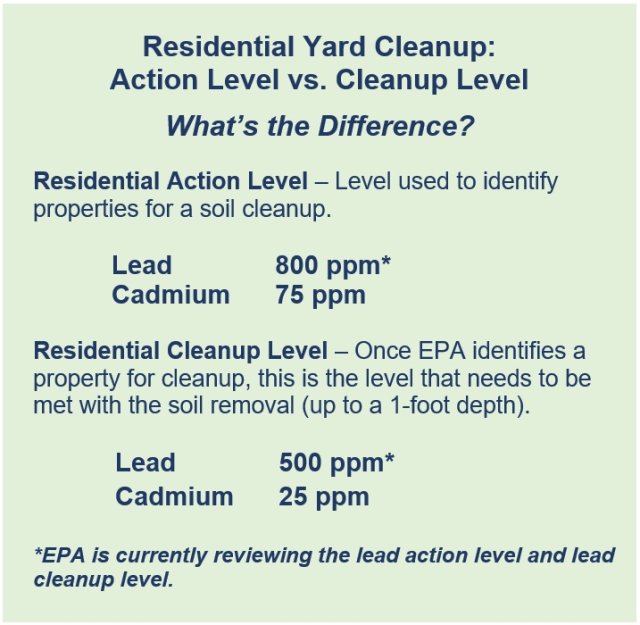
EPA also recognizes that the lead action level of 800 ppm used for the residential cleanups may not be protective.
The lead action level for the site was selected in the late 1990s. It was based on EPA guidance in effect at that time and derived from modeling that used a blood lead level of 10 micrograms per deciliter (µg/dL) as the level of concern. Evidence from more recent scientific studies show that blood lead levels below 10 µg/dL may also cause negative health impacts.
To address these issues, EPA plans to review residential yard sampling results and address the protectiveness of the historic action level of 800 ppm and the historic cleanup level of 500 ppm. EPA Region 7 is currently evaluating this cleanup level. If new residential development is identified within the site boundary, EPA will test the residential yards and address any that are impacted. EPA also plans to revise or create an operation and maintenance plan for each Operable Unit.
EPA reviewed a Kansas well records database and identified many shallow domestic wells within the site boundary. It is unknown if people are using water from the wells and if the well owners are aware of contamination in the water. To address this issue, EPA plans to identify and test domestic wells for site-related contamination. EPA will also plug any wells that may be allowing contamination to move into the deeper aquifer.
EPA also plans to review information about public water supply wells (which provide water from deeper wells) to ensure that cadmium and lead are not present above protective levels. EPA plans to request additional information about the public water supply well sampling results, and to identify and test new drinking water supply wells. EPA noted that restrictions on well drilling were not found at multiple county and state offices. It is also unknown if an existing institutional control in the Cherokee County Environmental Code is working to restrict well drilling. To address this issue, EPA plans to establish a county-wide plan to implement and review institutional controls to ensure they are effective.
OU5 – Galena Groundwater/Surface Water:
The OU5 remedy may not be working as intended for reducing risks associated with surface water exposures. Surface water sampling results from 2014 to 2016 indicate that zinc and cadmium levels exceed preliminary remediation goals. Lead was also elevated in one sample in 2016. EPA identified erosion issues at OU5. Several areas at OU5 do not have adequate vegetative cover. This may be causing the metals contamination in surface water. EPA found that the OU5 remedy does not address the potential future residential development of the area.
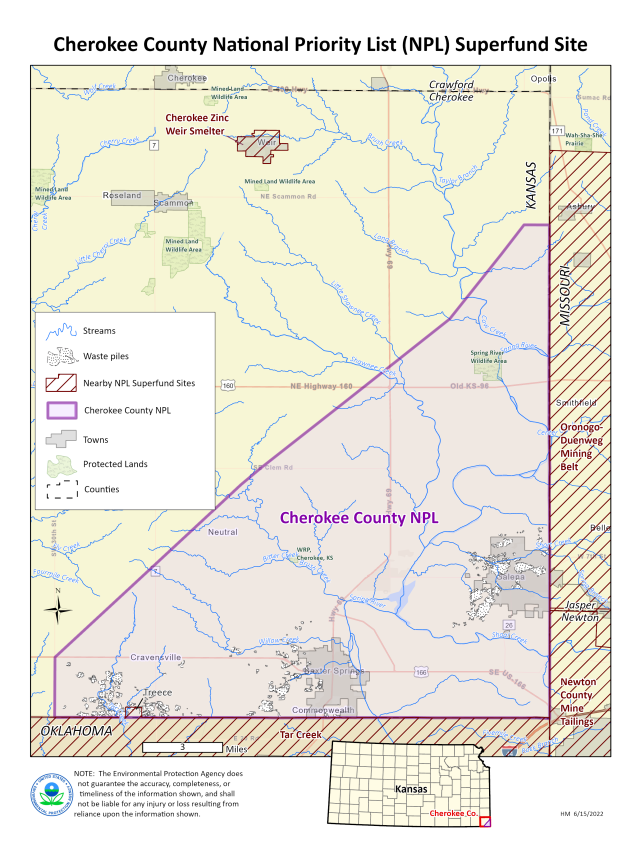
The OU5 soil action levels are not protective of residential use. There are likely properties that are in residential reuse. To address these issues, EPA plans to review or create an operations and maintenance plan for long-term maintenance needs. EPA also plans to evaluate the risks to animals living in water and on land, and to people at the Galena subsite.
Like at OU3 and OU4, there are concerns that shallow domestic wells may be in use within the site boundary; that no reported cadmium and lead data exist for the public water supply; and that it is unclear if the institutional controls in place to restrict well drilling are adequate.
The lead and zinc action levels for OU5 were based on human health risks and may not be protective for plants and animals. To address these issues, EPA plans to identify and test domestic wells for site-related contamination, and then plug wells, as needed. EPA will also request additional information about the public supply wells and sample any new public supply wells.
EPA will establish a county-wide plan to implement and review institutional controls to ensure they are working.
OU7 – Galena Residential Soils:
The OU7 remedy is complete, but there is no publicly accessible county-wide database of properties included in the cleanup. The lead action level of 800 ppm for the residential cleanup may no longer be protective. To address these issues, EPA plans to review residential yard sampling results and address the protectiveness of the historic lead action and cleanup levels. If new residential development is identified within the site boundary, EPA will test the residential yards and address any impacted residential soils. The contaminants of concern for OU7 were selected based on human health risk and may not be protective for plants and animals.
EPA did not select an action level for zinc at OU7, which has been selected as an ecological contaminant of concern in other site OUs.
EPA plans to evaluate possible plant damage caused by zinc in soil, develop recommendations for revegetation, and determine whether actions are needed to clean up remaining soils with potentially elevated zinc levels.
Five-Year Review Protectiveness Determinations
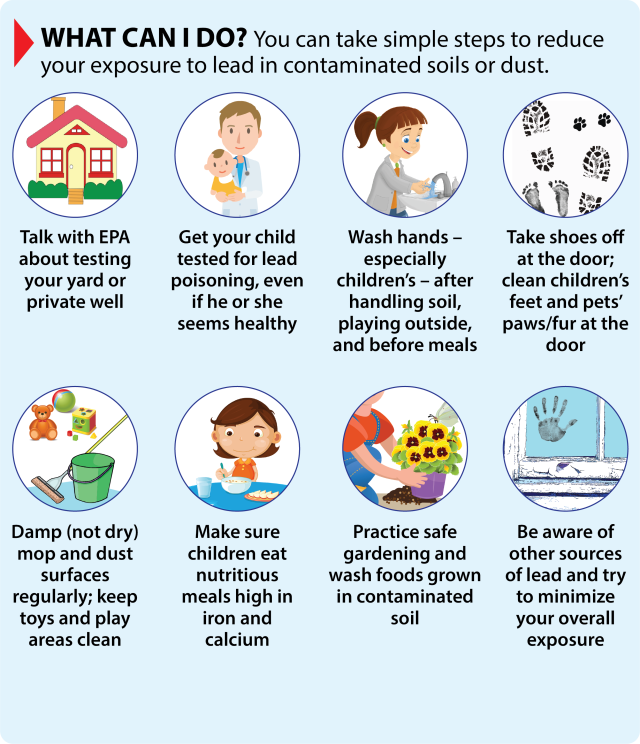
Like recommendations for OU3, OU4 and OU6, EPA also plans to identify and test new drinking water supply wells, establish a county-wide institutional control plan, and revise or create an operation and maintenance plan for long-term maintenance needs at OU7. EPA makes a protectiveness determination for each OU. Several possible protectiveness determinations are possible – protective, short-term protective, deferred, and not protective. Generally, these terms mean the following:
- Protective – The remedy is working as expected. People and the environment are not exposed to contamination at unacceptable levels.
- Short-term protective – The remedy may have some issues to address, but no one is currently being exposed to contamination at unacceptable levels.
- Deferred – More information is needed to determine if the remedy is protective for people and the environment.
- Not protective – An immediate threat to people or the environment may be present. There may be exposures or potential exposures to contamination that are not under control.
At the Cherokee County Superfund Site, EPA found that additional information is needed to determine whether the remedies at OU3, OU4, OU5, OU6 and OU7 are protective of human health and the environment. The protectiveness determinations for these OUs were deferred.
EPA will gather additional information and then assess the protectiveness of the remedies at these OUs.
The FYR did not include a protectiveness determination for the OU1 remedy because the state oversees the public water system.
Current Status and Next Steps
EPA is currently working with responsible parties and the state to address technical issues identified during the FYR. EPA is developing a Five-Year Review Report Addendum to be finalized in fiscal year 2023. In 2022, EPA began a Cherokee County Sitewide Assessment to test for potential lead contamination throughout the area.
Free Lead Testing and Cleanup Opportunity
If your property is located within the site boundary, EPA can test your property for FREE – including residential yards, private drinking water wells (groundwater), and other areas (such as playgrounds, agricultural areas, streams, and mine wastes). Contact EPA today!
For More Information, Contact Us
If you have questions about this Community Update and would like to receive site updates, and/or need more information, please contact EPA at:
U.S. Environmental Protection Agency, Region 7
11201 Renner Boulevard
Lenexa, KS 66219
Email: r7-tsmd@epa.gov
Toll-free: 1-800-223-0425
Elizabeth Kramer
Community Involvement Coordinator
913-551-7186
kramer.elizabeth@epa.gov
Todd Campbell
Remedial Project Manager
913-551-7115
campbell.todd@epa.gov
Brian Madeira
Remedial Project Manager
913-551-7638
madeira.brian@epa.gov
Additional Information
- Sixth Five-Year Review Report
- EPA Site Profile Page and Administrative Record File (see Site Documents and Data)
- EPA Sitewide Assessment Fact Sheet with Video Link
- Ways to Protect Your Family From Lead Hazards
- EPA News Releases and Feature:

